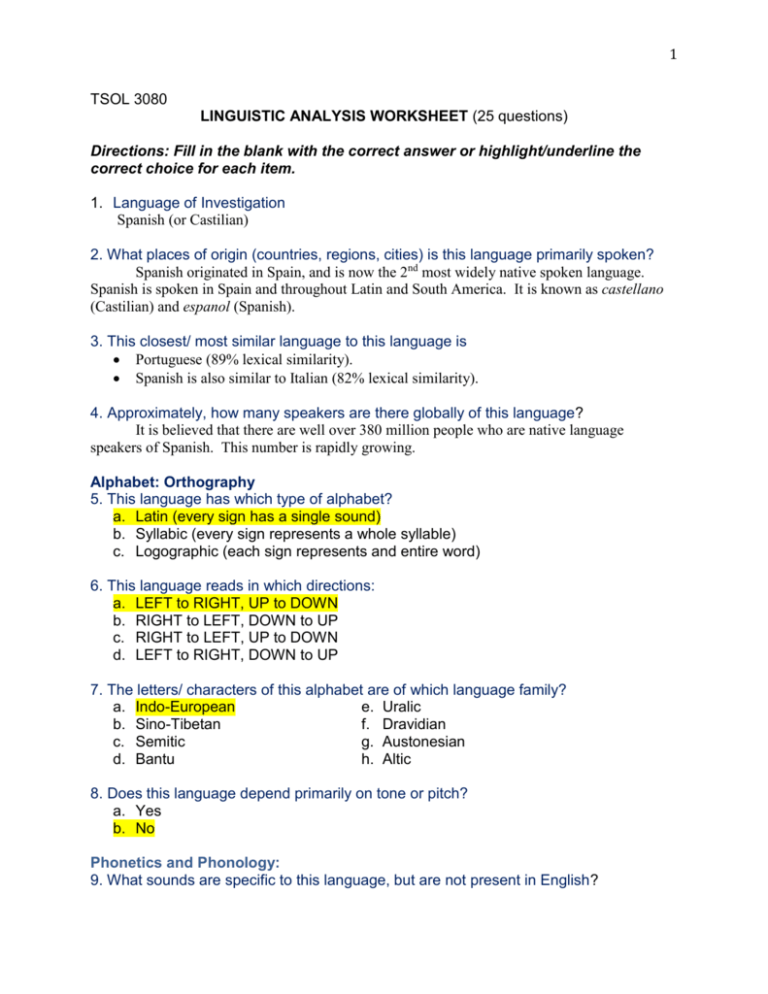Spanish - Linguistic Analysis
advertisement

1 TSOL 3080 LINGUISTIC ANALYSIS WORKSHEET (25 questions) Directions: Fill in the blank with the correct answer or highlight/underline the correct choice for each item. 1. Language of Investigation Spanish (or Castilian) 2. What places of origin (countries, regions, cities) is this language primarily spoken? Spanish originated in Spain, and is now the 2nd most widely native spoken language. Spanish is spoken in Spain and throughout Latin and South America. It is known as castellano (Castilian) and espanol (Spanish). 3. This closest/ most similar language to this language is Portuguese (89% lexical similarity). Spanish is also similar to Italian (82% lexical similarity). 4. Approximately, how many speakers are there globally of this language? It is believed that there are well over 380 million people who are native language speakers of Spanish. This number is rapidly growing. Alphabet: Orthography 5. This language has which type of alphabet? a. Latin (every sign has a single sound) b. Syllabic (every sign represents a whole syllable) c. Logographic (each sign represents and entire word) 6. This language reads in which directions: a. LEFT to RIGHT, UP to DOWN b. RIGHT to LEFT, DOWN to UP c. RIGHT to LEFT, UP to DOWN d. LEFT to RIGHT, DOWN to UP 7. The letters/ characters of this alphabet are of which language family? a. Indo-European e. Uralic b. Sino-Tibetan f. Dravidian c. Semitic g. Austonesian d. Bantu h. Altic 8. Does this language depend primarily on tone or pitch? a. Yes b. No Phonetics and Phonology: 9. What sounds are specific to this language, but are not present in English? 2 Spanish has ñ (like English /ny/) and a trilled r ɾ (usually indicated in writing as a double rr, as in perro). There are also several important differences between English and Spanish: j sounds like hard /h/; ll is similar to English /y/; h is not pronounced in Spanish; and b and v are both pronounced /b/. In Spain, z, ce, and ci sound like /th/; in Latin American Spanish the same letters are pronounced /s/. Spanish uses accents in some words, which can change the word’s meaning. 10. What sounds are found in English, but are not found in this language? The English language consists of approximately 44 sounds; Spanish has about 22 sounds. Some research states that English has twelve pure vowels sounds and eight dipthongs, compared to five pure vowels sounds and five dipthongs in Spanish. These additional sounds can be difficult for English learners to learn. Many of them are listed below. English has the following vowel sounds that Spanish does not have: short a, short i, short o, short u, short oo and the schwa sound. Spanish does not have /j/ as in jump, /v/ as in vase; /z/ as in zipper. The following vowel digraphs do not exist in Spanish: ou, ow, eigh, au, aw, oo Some English consonant digraphs do not occur in Spanish: sh, th, wh, ph These blends are not used in Spanish: sl, sm, sts, scr, spr, str The initial sounds: kn, qu, wr, sk and the final sounds: ck, ng, gh are not a part of Spanish. 11. What sounds do speakers of this language have difficulty pronouncing in English? Spanish speakers of English often have trouble with the additional vowel sounds of English. Because the length of the vowel sound makes a difference too in English, new speakers may have trouble hearing and pronouncing such words as ship/sheep, taught/tot, fool/full or cart/cat/cut. Spanish speakers may have trouble making the contrastive sounds between /s/ and /z/ (because in Spanish there are no voicing contrasts between fricatives). Speakers may voice the sound of a consonant following a fricative as well. In Spanish, there are mainly only five or six consonant sounds at the end of words (depending upon the dialect: s, n, r, l, and d), so speakers may have trouble with other ending sounds such as: –ed (/t/ sound may be changed to /d/), -s (endings that sound like /z/), -m (may turn sound into /n/ The /s/ sound in Spanish must immediately precede or follow a vowel, so when trying to read a word starting with s + consonant, the speaker may add a vowel to the word (e.g. stomp would be pronounced es’tamp). The d in Spanish can be pronounced /d/ or /θ/ -the th in father, making pronouncing words with a d a challenge for speakers. Syntax and Grammar: 12. The word order of this language is mainly a. Verb, subject, object (VSO) b. Subject, verb, object (SVO) c. Object, verb, subject (OVS) d. Verb, object, subject (VOS) e. Subject, object, verb (SOV) f. Lacks a dominant word order 3 13. Are there particular parts of speech that are represented differently (such as articles or prepositions)? Adjectives are added after a noun in Spanish (instead of before a noun, as in English). For example: caballo blanco instead of white horse. Adjectives can stand in for nouns in Spanish. Determiners must agree with their subject (in both gender and number). Definite articles are both singular and plural. Possessives follow a similar rule. Spanish includes many prepositions, but they are used more precisely than English ones. In English a prepositional phrase can change the understanding of a word (e.g. “He ran out of gas” and “He ran up the stairs.”). In Spanish, completely different verbs would be used in these examples. Word order and prepositions are typically used to indicate the function of a noun in a sentence in Spanish. For example, in the sentence Pedro ama a Adriana (Pedro loves Adriana), the preposition a is used to indicate which person is the subject and which is the object. In the English sentence, word order is used to indicate who loves whom. 14. How are tense and aspect indicated? In Spanish there are six unique spellings for each verb tense, while English usually alters the suffix of the verb to alter the tense. Also, there is no one-to-one correspondence in the use of the tenses, which may lead to some confusion in speaking and writing for Spanish speakers who are learning English. For example: I help you after school instead of I will help you after school; or She has a shower instead of She is having a shower. Spanish has two past tenses, and pretérito imperfecto (imperfect), which does not exist in English. Aspect, the usage of the preterite and the imperfect, is probably more confusing for English learners of Spanish. 15. What are the punctuation forms used in this language? List using English comparisons. Spanish and English punctuation is very similar. Areas that differ are listed below: Question marks are used at the beginning and the end of a question. The first mark is inverted. For example: Si no te gusta la comida, ¿por qué la comes? If you don't like the food, why are you eating it? Exclamation points frame an exclamation and sometimes a direct command. If a sentence contains a question and an exclamation, it is acceptable to use one of the marks at the beginning of the sentence and the other at the end. Again, the first mark is inverted. For example: Vi la película la noche pasada. ¡Qué susto! I saw the movie last night. What a fright! ¡Qué lástima, estás bien? What a pity, are you all right? A period is used the same as in English in regular text. In numerals, however, a comma is often used instead of a period and vice versa. (U.S. and Mexican Spanish usually follow the same pattern as English). For example: Gana $30.000 por año. He earns $30,000 per year. A dash is used to indicate a change in speakers during a dialogue; this replaces quotation marks. Written dialogue continues on one line, as opposed to starting new paragraphs for each speaker, as in English. 4 — ¿Cómo estás? — Muy bien ¿y tú? — Muy bien también. "How are you?" ¶"I'm fine. And you?" ¶"I'm fine too." Angled quotation marks and English-style quotation marks are equivalent. Their use is a matter of regional custom or typesetting capabilities. Angled quotation marks are more common in Spain than in Latin America. Sentence punctuation goes outside the quote marks. Quiero leer "Romeo y Julieta". I want to read "Romeo and Juliet." Quiero leer «Romeo y Julieta». I want to read "Romeo and Juliet." Capitalization rules vary just a bit: Adjectives of nationalities are not capitalized and days of the week as well as months are not capitalized. El viernes me pongo una camisa hawaiana. On Friday I wear a Hawaiian shirt. A colon is used in place of a comma in Spanish when beginning a letter or post. The comma is only used for short pauses and ascending intonation. Hola: Hello, 16. How does this language mark gender? Spanish, like other Romance languages, is a two-gender language. All nouns are given a feminine or masculine gender; there are no neuter nouns. The gender doesn’t change with the context and a noun’s gender determines the form of many adjectives that describe it. Masculine nouns are indicated by e; feminine nouns are indicated by la. Nouns and adjectives that end in -o (or -os for plural adjectives), -or or –al are generally masculine. Nouns and adjectives that end in -a (or -as for plural adjectives), cion, -dad, -sion, -tad, -tud- or -umbre generally are feminine. Some examples: el hombre gordo (masculine adjective, masculine noun); the fat man la mujer gorda (feminine adjective, feminine noun); the fat woman Morphology: Remember that cognates have the same origin; they are not simply words that sound alike. 17. If there are some shared cognates between English and this language, what are they? Both English and Spanish share Latin influences in their language, so there are many, actually thousands of, shared cognates. Noun Cognates – many nouns are identical, or have a simple suffix change between English and Spanish. A few examples: Cognate English Spanish English→Spanish -or = -or actor actor -al = -al hospital hospital -ist → -ista artist artista optimism -ism → -ismo optimismo patience -nce → -ncia paciencia identity -ty → -dad identidad 5 -tion → -ción -y → '-ía', '-ia', or '-io' Adjective Cognates Cognate English→Spanish -ive → ivo -al = -al -ous → -oso -ic → -ico -ble = -ble -nt → -nte -id → -ido -ile → -il -ary → -ario combination dictionary combinación diccionario English Spanish effective criminal generous electric impossible ignorant solid automobile arbitrary efectivo criminal generoso eléctrico imposible ignorante solido automóvil arbitrario Verbs- Many English verbs can easily be changed into Spanish verbs: Cognate English Spanish English verb →Spanish associate asociar -ate → -ar terminate terminar Verb ending in VOWEL + insult insultar CONSONANT + T → '-tar' or export exportar '-tir' English infinitive verb ending in VOWEL + CONSONANT + E → VOWEL + CONSONANT + 'AR' English infinitive verb '-ify' ificar' → '- adore declare adorer declarar gratify simplify gratificar simplificar Adverbs – In English many adverbs are formed by an adjective - ly and Spanish feminine adjectives with –mente form Spanish adverbs. Cognate English Spanish (see explanation unify unificar above) modify modificar 18. If there are some FALSE cognates between English and this language, what are they? There are quite a few false cognates as well as words that don’t always translate precisely. A few examples: False Cognate Spanish English Inferior may be used to refer to a When referring to a subordinate, carries subordinate in the worka derogatory connotation place, but doesn’t carry the 6 Informal embarazada actualmente carpeta violador derogatory meaning held in English unreliable pregnant Currently Folder rapist Aprobar eventual(mente) Pass (pass an exam) Temporary or conditional libreria introducir Bookstore Refers to the physical action of bringing up a topic in conversation or to insert carrera lectura departamento molestar Studies (as in schooling) Reading or text apartment and department To bother, disturb or annoy; can also mean to molest Commitment compromiso familiar A member of your family; your relative Casual Looks like embarrassed (apenado) Looks like actually Looks like carpet Looks like violator – as in someone who broke a traffic rule. Looks like approve Looks like eventually (in the end; in the long run), which is finalmente Looks like library (biblioteca) Looks like introduce (presenter) Looks like career Looks like lecture department Looks like molest - physical brutality Looks like compromise – making concessions In English we think of familiar as knowing something about something General word for a “relative” Looks like parents (los padres) Parent is padre (father) or madre (mother) There are many more false cognates – these are just a few that make it clear that studying vocabulary between English and Spanish is important. el/la pariente Semantics: 19. How is formality or respect expressed? When greeting an elder, shake hands, smile, and maintain eye contact. Although not entirely necessary, “Buenos días” (Good morning) or “Buenas Tardes” (good afternoon) is a simple and effective greeting. You may also greet with “Hola” (the reply is “Hola”). Then ask how they are doing using the formal greeting “¿Cómo está usted?" This means "How are you?" "Cómo" means "how" and "está" is the "usted" (the formal form) of the verb "estar" (to be). If you are in a health care or service-providing situation it may be more appropriate to ask “¿Como le puedo servir?” – “'How can I serve (help) you today?” Latinos/Hispanics prefer to be addressed by their country of origin: they are 'Cubans,' 'Salvadorans,' 'Mexicans,' etc... It is culturally courteous to address your patients by their country of origin. Therefore a good introductory statement is to ask them their country of origin. 7 It is considered polite to use "Sí, por favor; No, gracias; Sí, señora" when answering questions. 20. What is an informal expression in this language? What is the English translation/meaning? Less formal, friendly greetings might include a hug and kiss and asking how he is by using the "tú" form of estar, "¿Cómo estás?" The "tú" form is the informal pronoun used with friends and acquaintances. You would then ask his day is going with the expression "¿Qué tal tu día?" or ask him "What's up?" by saying "¿Qué pasa?" Telephone greetings vary from location to location - Hola, aló, jaló, bueno, al, diga. Hola would be understood anywhere but is not customary in many places. ¿Cómo te llamas? ¿Cómo se llama usted? — What's your name? — A literal translation would be "What do you call yourself?" or, somewhat less literally, "What are you called?" The first form normally would be used with a child, or possibly with someone of equal social status at an informal occasion. If you're uncertain which form to use, the second one is safer. Me llamo (nombre).— My name is (name). — A literal translation would be "I call myself (name)" or, somewhat less literally, "I am called (name)." You can also literally translate the English: Mi nombre es (nombre). Mucho gusto. Encantado. — It's a pleasure to meet you. — Either of these could be said upon meeting someone. If you're female, you should say encantada instead of encantado. These literally mean "much pleasure" and "delighted," respectively, so they would have different meanings in other contexts. Bienvenido, bienvenida, bienvenidos, bienvenidas — Welcome — Note the difference in number and gender. Bienvenido would be used with a man, bienvenida with a woman, bienvenidas with a group of all females, and bienvenidos with males or a mixed group. Pragmatics: 21. What is the common expression for greetings? (In English, we ask “How are you?”) The common expression for a greeting is “Hola” and “¿Cómo está usted?"(formal) or "¿Cómo estás?” (informal). This means, “Hello. How are you?” 22. Are there certain topics that are considered inappropriate or forbidden? Because the Spanish language is spread about so widely, this is a difficult question to answer. After reviewing several resources that touched taboo topics for specific countries, here are some general guidelines that would be helpful: Every country is fiercely proud of its heritage and its uniqueness. Do not discuss another country’s strengths; focus on the good of whatever country you are in. Do not bring up embarrassing political times in recent (or longer) history. Politics of any kind can be a very touchy subject as passions and opinions vary widely. Many individuals are of Roman Catholic backgrounds, so any topics or behaviors that question religion and faith, that have sexual innuendos or that are on the fringe of morality should be avoided. 8 Teaching Implications: 23. Through your research what have you found are the biggest difficulties of speakers of this language learning English? Please provide specific examples. One of the biggest difficulties for Spanish speakers learning English is becoming familiar with the additional vowel sounds in English. This challenge presents itself in hearing, speaking and writing the language. It is hard to differentiate between “bit” and “beat.” There are also some confusing consonants (v, b, s, /z/) that challenge speakers. These sounds can come at the beginning, middle, or ends of words, and may cause problems in each position of the word. Because most Spanish words end in only a handful of sounds, final consonant sounds are often ‘swallowed’ by those trying to learn English. Mastering the spoken rhythm of English (giving more time to accented syllables) may make speaking the language a challenge. English grammar is another area of difficulty. Using third person gender, pronouns and possessive pronouns appropriately can be a challenge: (She is making his bed). Understanding the English rules when using plurals is difficult too. For example: “These crayons are mines.” In Spanish an adjective can follow a noun, so when writing English we might see such phrases as “the woman tall”. Because Spanish adjectives agree in gender and number, we may see phrases like “the fats cats.” While there are many shared cognates between English and Spanish, learners will still need help understanding words with multiple meanings (e.g. He ran out of gas and He ran up the stairs) and will need to have vocabulary study exercises that focus on false cognates. 24. If you have an early production ELL who this language is their L1, what would be the most important thing you will teach them in regards to the difference between their language and English? It would be very important to let a Spanish L1 learner that there are many similarities between English and Spanish – giving them the scaffold that they know so much of the language already would be helpful. The differences to focus on would be the new vowel sounds and their various spellings, as well as the additional dipthongs. Working on ending sounds of words would be important as well. 25. What would you expect to be ongoing difficulties for intermediate ELLs who this is their L1? What areas would you still need to address even after they had mastered social English? Ongoing difficulties for intermediate ELLs would certainly be trying to master English grammar and applying the differing rules of English to their speaking and writing, while maintaining and understanding of the structure of their Spanish language. While students may have mastered social English, they would still benefit greatly from reading academic text as well as more conversational / lighter styles of writing. This would build vocabulary, help with understanding written structure, but still expose the student to more common phrasal verbs, which are needed for listening comprehension (for example: I talked my mom into letting me stay out late.) 9 Building vocabulary would be an ongoing task for these students. Perhaps having the student make their own glossary with words, pictures, usage examples and the word in the L1 would be helpful for comprehension.








